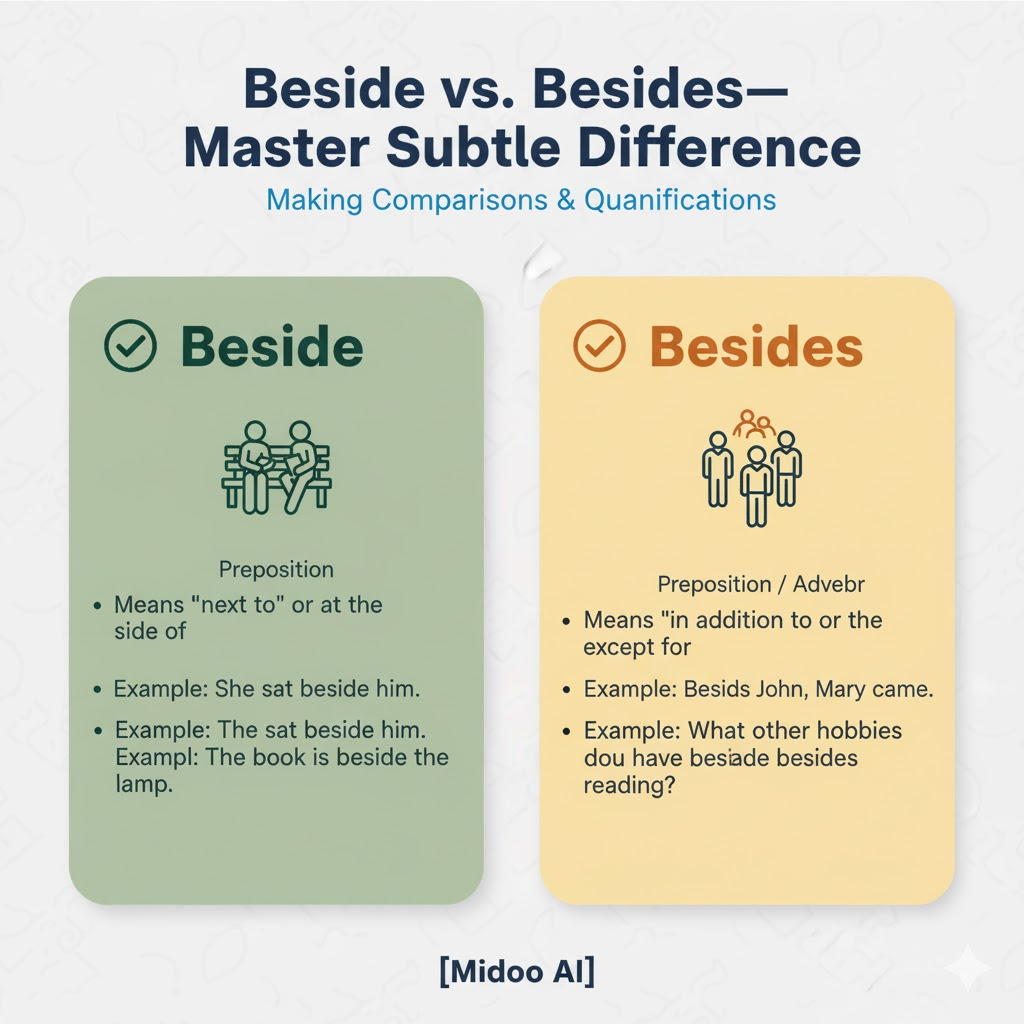Beside vs. Besides—Master the Subtle Difference

English is full of words that look almost the same but mean entirely different things—and beside and besides are a perfect example. If you’ve ever paused mid-sentence wondering whether to say “beside” or “besides,” you’re not alone.
At Midoo AI, we help English learners master these small but powerful distinctions that make writing and speaking more natural. Today, we’ll break down how beside and besides differ in meaning and use, so you’ll never mix them up again.
1. The Core Difference
Beside → Means “next to” or “by the side of.”
Besides → Means “in addition to” or “apart from.”
Although they differ by just one letter, their meanings are completely different—one is about position, the other about addition or exclusion.
2. Using “Beside” (Physical Position)
“Beside” refers to location or proximity—something or someone being next to another object or person.
Examples:
- She sat beside her best friend at the concert.
- There’s a lamp beside the bed.
- He stood beside his father during the ceremony.
- Please place your bag beside the chair.
💡 Tip: If you can replace the word with “next to” and it still makes sense, you should use beside.
3. Using “Besides” (Addition or Contrast)
“Besides” is an adverb or preposition that adds information or contrasts it. It means “in addition to” or “apart from.”
Examples:
- Besides English, she speaks French and Japanese.
- Besides being a talented singer, he’s also a great dancer.
- No one came to the meeting besides John.
- I don’t really want dessert. Besides, I’m full.
💡 Tip: If you can replace it with “in addition to” or “apart from,” use besides—not beside.
4. Quick Comparison Table
| Usage Type | Beside | Besides |
|---|---|---|
| Meaning | Next to / by the side of | In addition to / apart from |
| Function | Preposition only | Preposition or adverb |
| Example | She sat beside me. | Besides me, no one showed up. |
| Substitute | next to | in addition to / apart from |
5. Common Mistakes to Avoid
❌ She sat besides me during lunch.
✅ She sat beside me during lunch.
❌ Besides the table, there’s a chair. (if you mean next to)
✅ Beside the table, there’s a chair.
❌ I don’t like this one. Beside, it’s too expensive.
✅ I don’t like this one. Besides, it’s too expensive.
💬 Tip: Remember, “beside” is for physical placement; “besides” adds or contrasts ideas.
6. Easy Memory Tricks
- 🪑 Beside → Think “side by side.”
- ➕ Besides → Think “add something else.”
If it’s about where, use beside.
If it’s about what else, use besides.
7. Real-Life Examples
- She put her phone beside her notebook.
- Besides being tired, he was also hungry.
- The dog slept beside the couch.
- Besides music, she loves photography.
- He stood beside me the whole time.
- Besides, it’s too late to change the plan now.
FAQS
Q1: Can I use “beside” and “besides” interchangeably?
No. “Beside” means next to; “besides” means in addition to. Mixing them changes the meaning completely.
Q2: Is “besides” too informal for writing?
Not at all. It’s perfectly acceptable in both formal and informal writing, especially when adding a reason or contrasting an idea.
Q3: Is “beside” ever used figuratively?
Yes. In expressions like “beside the point,” it means irrelevant. Example: That argument is beside the point.
Q4: Can I start a sentence with “Besides”?
Yes, especially when adding an idea. Example: I don’t want to go out. Besides, it’s raining.